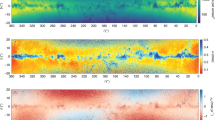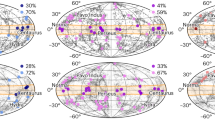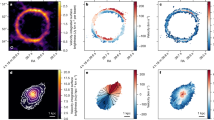Abstract
The prevalence of flat rotation curves in external galaxies1 strongly suggests an extensive but as yet unseen halo component. However, as direct observations of the implied matter distribution have proved very elusive, more indirect methods are needed to constrain its properties. At the same time, the explanation of observed warps in galaxies3–7 has been intensively studied by dynamicists, resulting in the appearance of many rival mechanisms (see ref. 8 for a review). For galaxies with companions, the tidal interaction theory is the most attractive, but fails to account for the observed bending of our Galaxy “by a factor approaching 3” (ref. 9). The problem of the rapid kinematical disruption which results if one follows particle orbits in a self-consistent disk is avoided if one accepts the existence of a dominant spherical (halo) component in the region of the warps8,10. Here, we explore the consequence of separating disk and halo mass distributions using a recently developed theory of bending waves2. In this theory, the height of bending allows the functional form of the disk density distribution to be determined. With proper normalization this determination allows the halo density to be inferred from the rotation curve. We will discuss the warps in our Galaxy and in galaxies NGC2841 and M33, for which a relatively complete set of reduced data is available.
This is a preview of subscription content, access via your institution
Access options
Subscribe to this journal
Receive 51 print issues and online access
$199.00 per year
only $3.90 per issue
Buy this article
- Purchase on Springer Link
- Instant access to full article PDF
Prices may be subject to local taxes which are calculated during checkout
Similar content being viewed by others
References
Rubin, V. C. IAU Symp. 84, 211 (1978).
Bertin, G. & Mark, J. W-K. Astr. Astrophys. (in the press).
Burke, B. F., Astrophys, J. 62, 90 (1957). Kerr, F. J. Astrophys. J. 62, 93 (1957).
Henderson, A. P. IAU Symp. 84, 493 (1978).
Bosma, A. thesis, Univ. Groningen (1978).
Rogstad, D. H., Wright, M. C. H. & Lockhart, I. A. Astrophys. J. 204, 703 (1976).
Sancisi, R. Astr. Astrophys. 53, 159 (1976).
Saar, E. M. IAU Symp. 84, 513 (1978).
Hunter, C. & Toomre, A. Astrophys. J. 155, 747 (1969).
Tubbs, A. D. & Sanders, R. H. Astrophys. J. 230, 736 (1979).
Kulsrud, R. M., Mark, J. W-K. & Caruso, A. Astrophys. Space Sci. 14, 52 (1971).
Mark, J. W-K. Astrophys. J. 206, 418 (1976).
Tsikoudi, V. thesis, Univ. Texas (1977).
Sandage, A. & Humphreys, R. M. Astrophys. J. Lett. 236, L1 (1980).
Bertin, G. & Mark, J. W-K. Astr. Astrophys. 64, 389 (1978).
Knapp, G. R., Tremaine, S. D. & Gunn, J. E. Astrophys. J. 83, 1585 (1978).
Oort, J. H. Bull. astr. Insts Neth. 15, 46 (1960).
Blitz, L., Fich, M. & Stark, A. A. in IAU Symp. 87 (in the press).
Larson, R. B. & Tinsley, B. M. Astrophys. J. 219, 46 (1978).
Houten, C. J., van Oort, J. H. & Hiltner, W. A. Astrophys. J. 120, 439 (1954).
Freeman, K. C. Astrophys. J. 160, 811 (1970).
Peebles, P. J. E. Lecture notes for L'Ecole d'Eté de Physique Théoretique, Les Houches (Gordon and Breach, London, 1979).
Author information
Authors and Affiliations
Rights and permissions
About this article
Cite this article
Lake, G., Mark, JK. Can galaxy warps be used to provide constraints on halo properties?. Nature 287, 705–706 (1980). https://doi.org/10.1038/287705a0
Received:
Accepted:
Issue Date:
DOI: https://doi.org/10.1038/287705a0
This article is cited by
-
Tilt of the central gas disk of the Galaxy (reply)
Nature (1982)
-
Why is the central gas disk of the Galaxy tilted?
Nature (1981)
Comments
By submitting a comment you agree to abide by our Terms and Community Guidelines. If you find something abusive or that does not comply with our terms or guidelines please flag it as inappropriate.



